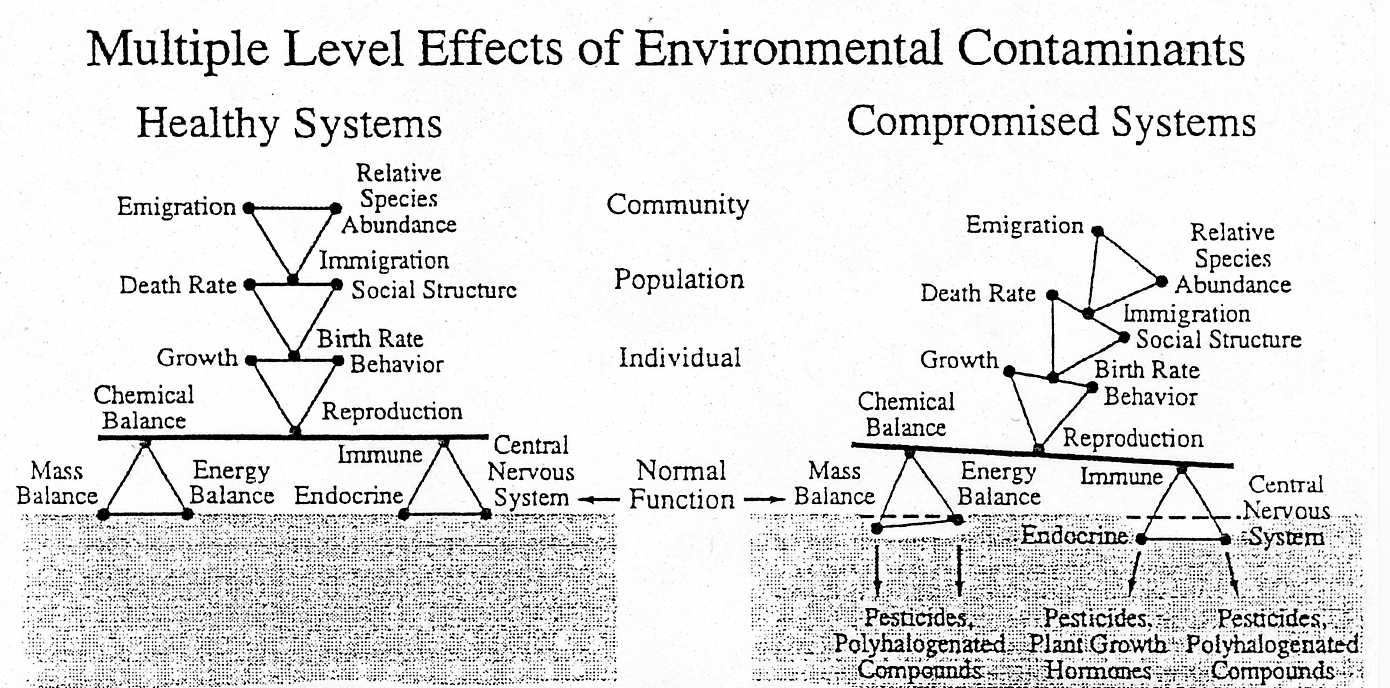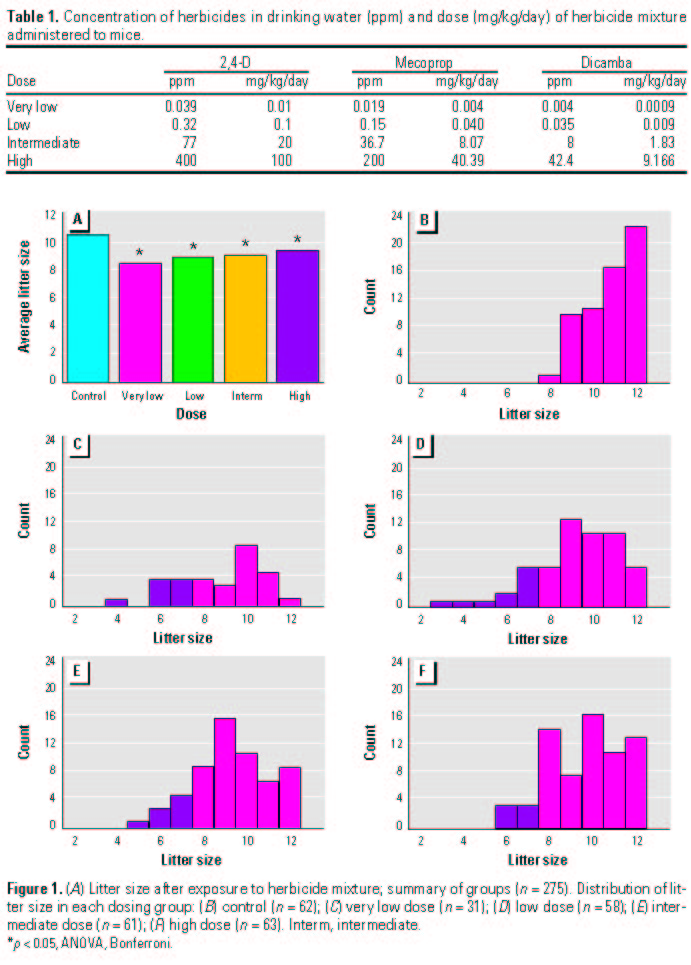
BIOLOGICAL EFFECTS OF LOW LEVEL PESTICIDE MIXTURES: PROBLEMS AND SOLUTIONS*
Quality
Assurance
A
field or yard full of dandelions is “quality assurance.” You do not have
to worry about kids or pets walking, running and/or playing in it. Why
is this so? The dandelions are a sure sign that the field or yard has
NOT been treated with pesticides.
Brief History
A
picture from an old National Geographic from 1945 showed a truck with
a large white cloud behind and children running through the cloud. Three
people were riding on the truck but not one of them was wearing a gas mask.
A sign on the truck read “DDT – Powerful Insecticide: Harmless to Humans.”
Literature
Wildlife research
has shown feminizing effects of pesticides. For example, the genitalia
of exposed male alligators in Lake Apopka, Florida, were so small, they were
almost invisible. Research showing pesticide effects on many species
is like the canary in a mine shaft—warning us of human effects.
Decreasing
Sperm Counts
Human
sperm count has been monitored since 1939. There are now well over 160
studies confirming a decline. See the following chart showing the sperm count
from 1939 to 1996 in many different countries. If we project the alarming
trend—in twenty years we will have zero population growth and in another twenty
years zero reproduction rate.

Reprinted with permission
There are already three countries in Europe with negative population growth. This chart is based on GLOBAL data from the United States, Western Europe, Latin America, India, Australia, and now China plus the former Soviet Union as well. In 1972 male sperm counts averaged 80 million sperm per milliliter. In 1992 there are only 60 million sperm per milliliter. The summary chart is from a 1992 paper in the British Medical Journal by Elizabeth Carlsen and colleagues from Denmark. A 1994 paper by Abell and colleagues, published in The Lancet, pointed out that while sperm counts from the rest of the world were decreasing, the sperm counts of organic farmers stayed high.
. . . three countries in Europe [have] negative population growth. This chart is based on GLOBAL data from the United States, Western Europe, Latin America, India, Australia, and now China plus the former Soviet Union as well. In 1972 male sperm counts averaged 80 million sperm per milliliter. In 1992 there are only 60 million sperm per milliliter.
The quality along with the quantity of sperm is decreasing as well, as evidenced by Pajarinen et al’s study (British Medical Journal, 314:13-8,1997) of percent normal sperm in human males. In 1980 the average sperm count in Helsinki Finland males was approximately 50% normal sperm. By 1992 that percentage had dropped to about 25% normal sperm. In 1932, 65% of men in the United States had sperm counts high enough for sperm banks. However, in 1992, only approximately 10% have high enough sperm counts for the sperm banks.
More
Teachers Needed for Special Education than for the “Three Rs”
Most
of all, Professor Porter is concerned about problems arising with children.
For example, according to an article in the February 10, 1997 issue of the Wisconsin
State Journal, in the Madison school district, which is recognized nationally
for its excellence, there is an alarming increase in children needing special
education. During the five years between 1990 and 1995, the rates of increase
are: for emotional, 87%; for learning disabilities, 70%; for birth defects,
83%. Similar increases in all these problems are occurring in California,
New York, Pennsylvania, Iran, Europe, and Australia. We do not know the
reasons for this epidemic but there are clues.
Example from Yaqui
Valley
The
Yaqui Valley is located in Mexico, and populated mostly by Native Americans
of Mexican descent. In the late 1940s, the valley was bought by
agricultural interests who planted large monoculture farms using pesticides.
Half the native people moved out of the valley into the surrounding mountains
to escape this forced exposure to pesticides. It wasn’t long before special
doctors were called in to examine the people in the valley. The women
were dying from breast cancer and their children seemed “different.” The valley
children had more aggressive behavior than the normal children in the hills.
The special doctors worked with pre-school children. They tested motor
coordination, stamina, and memory. The most revealing test was drawing
abilities of the valley children compared to the foothill children. They
were asked to draw a human being with these results:

Drawings of a person by 4-year-old Yaqui children from the valley and foothills

Drawings of a person by 5-year-old Yaqui children from the valley and foothills
Reprinted with permission
You can easily see how much worse the drawings are from the pesticide-exposed valley children on the right half of the illustration. These children show massive loss of neurological integration, which is essential for learning ability. Guillette et al, Environmental Health Perspectives 106(6):347-53, June 1998).
Pesticides
Registered with the EPA are NOT Safe
There
are many crucial shortcomings in the current toxicity testing protocols used
by the EPA. Professor Porter named six:
DREAMS for public awareness
Pulse Dose Exposures
Most pesticides can
penetrate our immune defenses by using “pulse dose exposure.” This is
described by imagining a stranger approaching you smiling with his hand held
out, and then suddenly he punches you in the stomach. When you put up
your hands to defend yourself, he backs off smiling. After you get tired
of holding up your hands and let them down, he suddenly rushes in and hits you
again. Most of our defenses against foreign invaders exist in our liver.
The special enzymes can take from half a day up to five days to develop.
Pulse dose pesticides can penetrate in a few minutes (like the smiling stranger
hitting you before your hands are raised in defense).
The level of thyroid hormone exposure is crucial to development. Children with improper thyroid levels are impossible to teach because they are either bouncing off the walls in hyperactivity, or with low thyroid, they couldn’t care less. Unfortunately, if a mother rat’s thyroid is too high or low during a crucial two-day window early in fetal development, the fetal hind brain may not develop properly. Mouse fetuses can respond to hormonal differences in the parts per trillion. Human fetuses may, too.
One thing we consistently see with pesticide exposures is that thyroid levels change. . . . Children with improper thyroid levels are impossible to teach because they are either bouncing off the walls in hyperactivity, or with low thyroid, they couldn’t care less.
Proper functioning of the hind brain is crucial in developing the foundations for ability to learn. The hind brain is the seat of motor coordination. A complex system of sites, muscle stretch receptors, and other sensory input allows infants to determine the shapes of objects. Early in postnatal life, all of us first reach out and put our hands around objects to feel their shape ( muscle stretch receptor and tactile information) and observe patterns of light from left to right across the object. All this sensory motor information is used to register the three dimensional pattern in our brain. This includes all the grays and shadows. It is likely that humans respond to hormones of the same order of magnitude as experimental animals. If this is the case, one might hypothesize that children exposed to pesticides may have altered neurological development. One potential consequence of this can be children with the inability to interpret three dimensional objects or draw them properly, as was illustrated by the children from the Yaqui valley.
More Pesticide Hazards
Round-Up
and Steroid Hormone Effects
Round-Up
has been shown to change gene expression in animals. Is this relevant
for humans? Ninety-seven to ninety-eight percent of our genes are the
same! Changes in gene expression can affect the immune system, steroid hormones,
and have effects throughout our bodies. Just this year experiments showed
Round-Up effects on early cell division in embryos.
Round-Up and Defense
Enzymes
We
are told that Round-Up is “very safe.” However, way back in 1983, it was
found that it can suppress liver defenses.
What is a pesticide? It is a neurotoxin, designed to kill. It includes insecticides, herbicides, and fungicides. From the diagram below, you can see that everything at ALL levels – the individual, population, and community is based upon and supported by what happens at the cellular/molecular and organ system level. The right and left figures represent a hypothesis that compares healthy and sick systems. You can see that in the sick situation, the critical cellular/molecular support level has been undermined on both the mass and energy balance (from proper nutrition) side, as well as on the immune/endocrine/nervous system side.

Reprinted with permission
Parkinson’s Disease
and Pesticide Chemicals
A
1992 study in Canada, published in Neurology by Karen Semchuk and
colleagues, of 130 farmers with confirmed Parkinson’s disease and 260 controls,
found that frequent herbicide exposure was the one significant variable and
was associated with a three times risk of Parkinson’s disease. Several
other studies have come to the same conclusion.
A clue for the reasons herbicides might be associated with neurological disease came from Swedish research with some tests on frogs and mice. The herbicides paraquat and diquat accumulate in the neuromelanin (a black colored cover for nerves, found in humans and animals). Also, it was discovered that MPTP, a break-down product of these herbicides, a highly electric product with strong positive charges, was attracted to the mitochondria, which produce the energy in all our cells. The consequence is a massive cascade of high-energy electrons, which destroy nerves in the brain.
Pesticides and the
Immune System
A
book titled Pesticides and the Immune System by Robert Repetto and Sanjay
Baliga first came out in 1995 or 96. Before this book came out, a toxicology
textbook had a table containing only 14 entries on pesticides and the immune
system. In Repetto and Baliga’s book, the table, describing more recent
findings, has grown to fourteen pages!
In the section on “Host resistance to bacteria and fungi,” many pesticides in the huge categories— organochlorines, organophosphates, and carbamates—all had an arrow pointing down, which indicates lowered resistance. The first two categories reduce resistance to viruses and parasites and organophosphates reduce overall resistance.
Herbicide
“Inert Ingredients” Allowing Rapid Insertion
When
you read the label list of ingredients on a herbicide, you will find about 40%
are “inert ingredients.” These ingredients actually allow rapid insertion
through the skin and penetration of the lungs and the lining of the digestive
system.
“Inert” ingredients in herbicides are designed to go through the waxy surface of leaves (the soaps) and through their breathing pores (the surfactants). Our skin is similarly waxy and our lungs easily penetrated by surfactants. Thus, the pesticide goes directly into our bloodstream through our skin and lungs, not through our liver with its detoxifying enzymes that can protect us.
Design
of Pesticide Molecules
Pesticide
molecules are designed with (a) positively or negatively charged atoms that
form a water soluble portion combined with (b) a carbon ring to form
a lipid soluble portion. After the lipid soluble part of the molecule
has dissolved through the cell wall, the electrostatically charged portion
is attracted to the oppositely charged parts of the cell. As an example,
a positively charged molecule would be attracted to negatively charged
mitochondria with their high energy electrons that fuel all our
living systems. The positive charges on the pesticide are also attracted
to the negatively charged DNA ladder, allowing the possibility of sliding in
between the “rungs” and, when the DNA “unzips” to copy itself, it may break
at this point and create a mutation. It takes only three critical mutations
to start cancer. Professor Porter refers to these kinds of fat soluble
molecules as “molecular bulls in a China shop.” These molecules have virtually
limitless opportunities for interaction with cell molecules involved in signal
transmission within and between cells, and the many internal cell molecules,
which also have electrostatic charges.
. . . a positively charged molecule would be attracted to negatively charged mitochondria with their high energy electrons that fuel all our living systems. The positive charges on the pesticide are also attracted to the negatively charged DNA ladder, allowing the possibility of sliding in between the “rungs” and, when the DNA “unzips” to copy itself, it may break at this point and create a mutation. It takes only three critical mutations to start cancer. Professor Porter refers to these kinds of fat soluble molecules as “molecular bulls in a China shop.” These molecules have virtually limitless opportunities for interaction with cell molecules involved in signal transmission within and between cells, and the many internal cell molecules . . .
Consequently, pesticides get past our defenses and into our bodies in three ways: through our mouth, through our lungs, and through our skin. Once in the blood stream they may relatively easily penetrate the blood/brain barrier due to lipid soluble properties. Thus, they have the potential to affect the nervous, immune, and endocrine systems.
Some Research
Professor
Porter asked the Department of Natural Resources what was in the groundwater
of central Wisconsin. The answer was aldicarb, methomyl, and metribuzin,
two insecticides and a herbicide. All of these compounds are immune suppressants
at concentration levels of one, a hundred,
and a thousand
parts per billion.
Three concentration levels were used to explore interactive effects, as well as main effects of mixtures of the three pesticides. This study measured pesticide effects on neurotransmitter and thyroid concentrations. The herbicide made learning much, much slower. The herbicide gave significant increases in thyroid hormone concentrations (Journal of Toxicology and Environmental Health, 40:15-34, 1993).
Two maps of central California showing pesticide use and incidence of thyroid cancer showed remarkably similar patterns. Porter reminded us that this is correlation only, and not proof of cause and effect.
Research on Mixtures
We
are exposed to mixtures of pesticides and
other chemicals. Professor Porter decided to study the most commonly used
agricultural chemicals contaminating groundwater in the United States at levels
that are widely detected in groundwater, specifically: aldicarb, an insecticide,
atrazine, a herbicide, and nitrate from fertilizer, which co-occurs with virtually
all pesticide applications, especially in the spring. In five years
of experiments, beginning in 1990, the researchers used two strains of mice,
testing for aggression, curiosity, learning speed, immune reaction to a foreign
chemical, plus thyroid hormone assays.
Aldicarb and atrazine alone had little or no effect , but the mixtures did. However this didn’t happen all the time. After they found no significant correlations by concentration levels, they tried sorting by season. There they did find a pattern. The mice were most vulnerable in the winter and in the spring.
Here is a list of the results they found on each system:
Nervous: reduction in spatial discrimination, which is crucial for learning; reduction in exploratory behavior, memory, motor coordination, and learning speed; and changes in aggression, depending on the season and the mix.
Endocrine: altered thyroid and growth hormone levels and a suggestion of changes in food absorption.
Immune: fewer antibodies, less ability for white blood cells to gobble up foreign cells, implying less ability to suppress disease (Toxicology and Industrial Health, 15:133-50, 1999).
Effect
of Mixtures on Fetal Implantation and Litter Size
The
next question was: What effect will a pesticide mixture have on the implantation
of fetuses and on litter size? They chose a regular commercial herbicide
mixture: 2,4-D, mecoprop, dicamba, plus “inerts.” This commercial mixture
of three herbicides was tested on mice with these results.
In Table 1 below, the second or “Low” dose is considered “safe” by the EPA. The “Very low dose” was in parts per billion—equivalent to one drop of water in 500 bathtubs. Is this dose environmentally relevant? Amazingly, the answer is “Yes!” The worst effects—the greatest losses in litter size were at this very low dose, as can be seen in the vertical bar graphs (Environmental Health Perspectives, 110(11):1081-5, November 2002).
View/Print original, crisp, clean *.pdf version of these graphs

Reprinted with permission
This “U” shape result is not uncommon. The greatest effects occur at the lowest doses—there are now published data showing analogous “U” shape response curves for hormone, immune function, and neurological function. The mechanisms that underlie this response are not understood yet. It may be negative feedback between two or more hormonal systems. It may involve the recently discovered properties of certain enzymes that have “switching” properties in metabolic pathways. Small changes in concentration can alter where they route molecules for processing. It is known that during the monthly menstrual cycle of human females, estrogen levels that change cause different responses at different hormone levels during the cycle.
Change
Market Share
Corporations
are exquisitely sensitive to their market share. A change of only 0.05%
can have a significant impact on a company’s future production plans. Educate
the public, your friends, neighbors, relatives as to the harm from all these
pesticides that are currently so widely spread throughout our society.
Avoid the pesticides and buy safe alternatives instead.
Change Research Funding
The way research is funded currently
at the National Science Foundation is not a problem. In biology 85% of
the research proposals are deemed worthy of funding. However, only 15%
receive funding. It would be the equivalent of Professor Porter telling
his students: “For this course, some of you will be very lucky, and the
others very unlucky. Your entire grade will depend on a term paper you
will write throughout the course. I will never look at any of them or
give you any feedback. At the end of the course, I will collect all your
papers and give them to five teaching assistants (TAs). If any one of
the TAs disapproves of your paper, you will get an F. The 15% who can
get approval from all the TAs will get an A.” It only takes one rejection
for a project to be out. Porter funds most of his research out of his
own pocket and from private donations. Helping him out would be a good
investment.
Many Safe Alternatives
Key
Question
How
do you know that what you do is right? Answer: You can never know. You
only know that you will have to live with the consequences of what you do or
fail to do.
Possible Consequences of Doing Nothing:
When we walk on grass without dandelions, is it safe?
The Co-Pilot
There was an airline
pilot who flew 747s and had a perfect safety record and perfect landing patterns.
However, he had never taken a physical exam. For years he was required
to do so, but had always refused. Finally, he was forced to, gave in,
and took the exam. He passed everything with flying colors, until he came
to the eye test for his vision. There, he could hardly even read the large
E at the top of the chart. The doctors were amazed! They asked the
pilot how, with such poor vision, he had maintained his perfect safety record.
“Oh that was easy,” the pilot replied. “Whenever we take off, I can easily
see the wide taxiways, and can point the plane properly down the main runway.
I just push the throttle lever forward, and once we’re in the air, I switch
it to auto-pilot.” “But how can you possibly land safely?” the doctors
asked. “Oh that’s easy too,” the pilot said. “I just push the stick forward
and down, down, down we go . . .” “But why don’t you crash?” the doctors
asked. “I just keep going down and down and down lower until the co-pilot
shouts ‘We’re going to crash!!’ and I pull back.”
Society is the pilot—blindly using pesticides without the slightest knowledge of the consequences. We can be the co-pilot. We all should join the co-pilot—waking up society!
____________
*Brief summary of a lecture by Warren P. Porter, PhD, Professor of Zoology and Environmental Toxicology, University of Wisconsin at Madison. His lecture was the keynote address at the 35th Annual Meeting of the Lake Michigan Inter-League Group of the League of Women Voters, October 4, 2002 in Fond du Lac, Wisconsin. Professor Warren Porter’s web site is: www.warrenporter.com
Article from NOHA NEWS, Vol. XXVIII, No. 2, Springl 2003, pages 1-6.